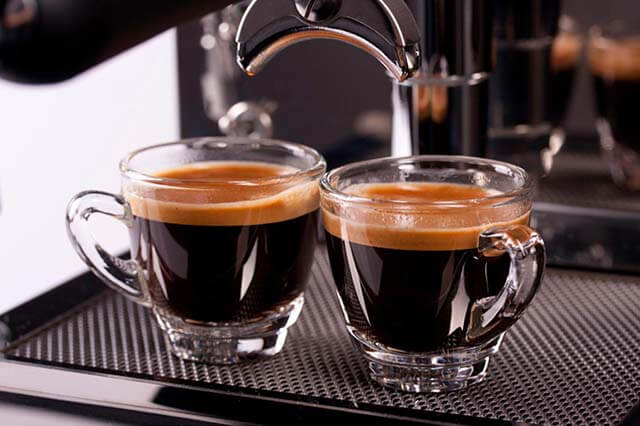
What is Espresso?
Espresso is a concentrated coffee beverage that originated in Italy in the early 20th century. It is made by forcing hot water, typically around 190-200 degrees Fahrenheit (88-93 degrees Celsius), through finely-ground coffee beans at high pressure, usually 9 bars or more. The process extracts the flavorful and aromatic compounds from the coffee, resulting in a small, concentrated shot of coffee with a rich, bold flavor and a signature layer of crema—a creamy, reddish-brown froth—on top.
Espresso is the base for many popular coffee beverages, such as cappuccino, latte, macchiato, and mocha. It is also enjoyed on its own as a quick, intense coffee experience.

Characteristics to identify standard Espresso
A standard espresso has several distinct characteristics that set it apart from other coffee beverages. These characteristics include:
- Volume: A typical espresso shot is small, usually around 1 ounce (30 milliliters) for a single shot and 2 ounces (60 milliliters) for a double shot.
- Extraction time: The extraction process for a standard espresso should take between 25-30 seconds. This time frame ensures the optimal balance of flavors and strength in the final shot.
- Coffee grounds: Espresso is made with finely ground coffee beans, contributing to the beverage's concentrated flavor and thick body. The grind size should be fine enough to create resistance when hot water is forced through it but not so fine that it clogs the espresso machine.
- Pressure: The brewing process involves forcing hot water through the coffee grounds at high pressure, usually 9 bars or more. This pressure contributes to the unique texture and flavor of espresso.
- Crema: A well-made espresso will have a layer of crema on top, a reddish-brown, creamy froth formed by emulsified oils from the coffee beans. The presence of crema is an indicator of a properly extracted espresso.
- Taste and aroma: Espresso has a rich, bold flavor with a balanced bitterness, acidity, and sweetness. The aroma should be intense, with caramel, chocolate, nuts, or fruit notes depending on the coffee beans used.
- Body and mouthfeel: Espresso has a thicker, more syrupy body than other coffee brewing methods. The mouthfeel should be complete and velvety, leaving a pleasant aftertaste.
Note that these characteristics can vary depending on factors such as the coffee beans used, the freshness of the beans, the roast level, and the barista's skill.
What are some common Espresso extraction scenarios?
Several common espresso extraction scenarios can affect the quality and taste of the final shot. These scenarios include:
- Ideal extraction: The optimal extraction scenario results in a balanced, rich, and flavorful shot of espresso. This is achieved when the grind size, water temperature, pressure, and extraction time are all within their ideal ranges.
- Under-extraction: This occurs when the espresso shot is pulled too quickly, typically due to coarse grind size, low pressure, or a short extraction time. Under-extracted espresso often tastes sour or acidic, with a weak or watery body lacking complexity.
- Over-extraction: Over-extraction happens when the shot is pulled too slowly, often due to a grind size that is too fine, too much pressure, or a long extraction time. Over-extracted espresso tends to taste bitter, burnt, or astringent, with a heavy body and a lingering, unpleasant aftertaste.
- Channeling: This scenario occurs when water finds an easier path through the coffee puck, resulting in uneven extraction. Channeling can be caused by the uneven distribution of coffee grounds, inconsistent tamping, or damage to the espresso machine's components. The resulting shot may have under-extracted and over-extracted flavors, making it unbalanced and unpredictable.
- Blonding: Blonding refers to the lightening of the espresso as it flows from the machine towards the end of the extraction. While some blonding is normal, excessive blonding can indicate an issue with the extraction process, such as a coarse grind or uneven tamping. An overly blond shot may taste weak, sour, or watery.
To achieve the best espresso extraction, it's crucial to pay attention to the coffee beans' quality, freshness, and roast level, as well as the proper calibration and maintenance of the espresso machine. Additionally, mastering the techniques of even distribution, consistent tamping, and precise grind size adjustment can significantly improve the quality of the espresso.
Characteristics to distinguish between fast and slow Espresso extractions
Fast and slow espresso extractions can be distinguished by several characteristics, mainly in flavor, body, and visual cues. Here's a comparison of the two:
Fast Extraction (Under-extracted):
- Extraction time: Typically takes less than 25 seconds, as water passes through the coffee grounds too quickly.
- Visual cues: The shot may appear lighter in color, with thin or watery crema that dissipates quickly.
- Flavor: Tends sour or acidic, with weak or undeveloped flavors lacking complexity.
- Body and mouthfeel: The espresso may have a thin, watery body with little texture or richness.
Slow Extraction (Over-extracted):
- Extraction time: Usually takes more than 30 seconds, as water flows too slowly through the coffee grounds.
- Visual cues: The shot may appear darker, and the crema can be darker and thicker than in an ideal extraction. Additionally, the stream of espresso may be slow and thin (sometimes referred to as "rat tails").
- Flavor: Tends bitter, astringent, or burnt, with heavy or harsh flavors that overpower the coffee's natural nuances.
- Body and mouthfeel: The espresso may have a heavy, thick body with a lingering, unpleasant aftertaste.
By paying attention to these characteristics, you can adjust the grind size, tamping pressure, and other factors to make the ideal extraction for a balanced and flavorful espresso.
Không có nhận xét nào:
Đăng nhận xét